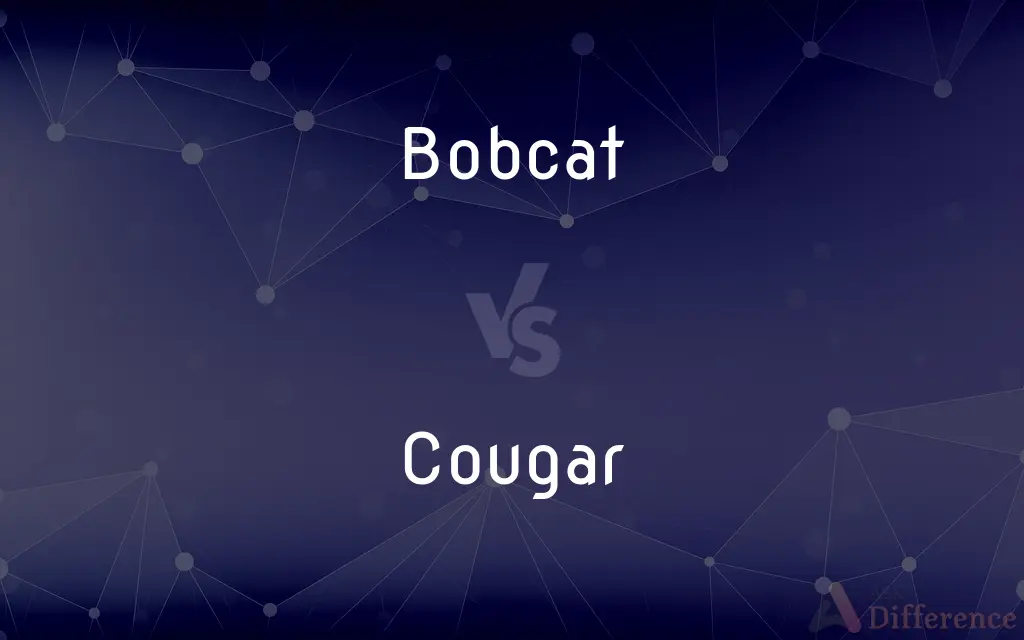Bobcat vs. Cougar — What's the Difference?
Edited by Tayyaba Rehman — By Maham Liaqat — Updated on February 21, 2024
Bobcats are smaller, adaptable predators with tufted ears and short tails, prevalent across North America. Cougars, significantly larger and more powerful, range wider, preferring mountainous regions.

Difference Between Bobcat and Cougar
Table of Contents
ADVERTISEMENT
Key Differences
Bobcats are compact, elusive wildcats known for their distinctive tufted ears and short "bobbed" tails, thriving in diverse habitats from forests to urban edges across North America. Cougars, also known as mountain lions, stand out for their size, strength, and long tails, dominating larger territories that span from Canada to South America, favoring mountainous terrains but adaptable to various environments.
Bobcats typically hunt small to medium-sized prey like rabbits and rodents, showcasing their stealth and agility, while cougars target larger animals such as deer, demonstrating their power and strategic hunting prowess. Both species are solitary and territorial, but cougars command vast ranges compared to the more modest territories of bobcats.
Bobcats and cougars both exhibit crepuscular behavior, being most active at dawn and dusk, yet their social structures differ markedly. Bobcats tend to have more overlapping territories, especially in resource-rich areas, whereas cougars maintain larger, more exclusive ranges to support their dietary needs.
In terms of physical appearance, bobcats have distinct spotted coats and their namesake bobbed tails, which contrast with the generally more uniform, tawny to grayish coat of cougars and their long, expressive tails. These physical differences are key adaptations to their respective hunting styles and environments.
Comparison Chart
Size
Small to medium, 2-3 ft long
Large, up to 5 ft long without the tail
ADVERTISEMENT
Weight
15-35 lbs
70-220 lbs
Habitat
Forests, swamps, urban edges
Mountains, forests, jungles
Prey
Small/medium animals: rabbits, birds
Larger animals: deer, elk
Physical Traits
Tufted ears, short tails, spotted coat
Long tails, uniform color, larger build
Compare with Definitions
Bobcat
A small North American wildcat with tufted ears and a short tail.
The bobcat prowled silently through the underbrush.
Cougar
A large wildcat also known as a mountain lion, with a notable long tail.
The cougar leaped effortlessly over the fallen log.
Bobcat
Known for its adaptability to various environments.
A bobcat was spotted on the edge of the urban park.
Cougar
Predominantly hunts larger prey such as deer.
A deer carcass was found, likely the work of a cougar.
Bobcat
Recognized by its distinctive spotted coat.
The bobcat's spotted coat blended seamlessly with the fall foliage.
Cougar
Solitary with large territories, rarely overlapping with others.
The cougar roamed its vast territory in search of food.
Bobcat
Hunts primarily small to medium-sized prey.
The bobcat pounced on an unsuspecting rabbit.
Cougar
Roams extensively across the Americas, preferring mountainous regions.
Tracks of a cougar were found near the mountain trail.
Bobcat
Exhibits a solitary and territorial behavior.
The male bobcat marked his territory at dusk.
Cougar
Characterized by a uniform tawny to grayish coat.
The cougar's tawny coat camouflaged it against the rocky terrain.
Bobcat
A wild cat (Lynx rufus) of North America, having spotted reddish-brown fur, tufted ears, and a short tail. Also called bay lynx.
Cougar
The cougar (Puma concolor) is a large cat of the subfamily Felinae. Native to the Americas, its range spans from the Canadian Yukon to the southern Andes in South America and is the most widespread of any large wild terrestrial mammal in the Western Hemisphere.
Bobcat
Small lynx (Lynx rufus) of North America.
Cougar
An American feline quadruped (Felis concolor), resembling the African panther in size and habits. Its color is tawny, without spots; hence writers often called it the American lion. Called also puma, panther, mountain lion, and catamount.
Common Curiosities
What distinguishes a bobcat's habitat from a cougar's?
Bobcats adapt to a range of environments, including urban fringes, while cougars prefer secluded mountainous areas.
What are the key physical differences between bobcats and cougars?
Bobcats are smaller with tufted ears and short tails, whereas cougars are larger with long tails and a more uniform coat.
Are bobcats as dangerous to humans as cougars?
Both are generally shy and avoid humans, but cougars pose a greater risk due to their size and strength.
How does the range of a cougar compare to that of a bobcat?
Cougars have larger ranges, necessary for their larger prey, compared to the smaller ranges of bobcats.
How do bobcat and cougar tracks differ?
Bobcat tracks are smaller with no claw marks, while cougar tracks are larger and may sometimes show claw impressions.
Can bobcats and cougars coexist in the same area?
While their territories can overlap, they generally occupy different niches, minimizing direct competition.
How do the social behaviors of bobcats and cougars compare?
Both are solitary, but bobcats may have overlapping territories, unlike the more solitary and territorial cougars.
What factors contribute to the bobcat's adaptability?
Bobcats' diverse diet and ability to live close to human settlements contribute to their adaptability.
Do bobcats and cougars have the same predators?
Both have few natural predators, but young individuals can fall prey to wolves, bears, and other large carnivores.
How do bobcat and cougar hunting strategies differ?
Bobcats hunt smaller prey using stealth, while cougars target larger animals, often using power and ambush.
What role do bobcats and cougars play in their ecosystems?
They are apex predators, controlling the population of smaller prey and maintaining ecological balance.
Are there any conservation concerns for bobcats and cougars?
While bobcats are generally stable, cougars face habitat loss and fragmentation, posing challenges for their populations.
What is the significance of the bobcat's "bobbed" tail?
The bobbed tail is a distinctive physical trait, though its exact significance in communication or behavior is unclear.
How does the cougar's long tail benefit it?
The long tail aids in balance and agility, especially during high-speed chases or navigating rocky terrain.
How do bobcats and cougars communicate with each other or other species?
Both use vocalizations, scent markings, and body language for communication, with specifics varying between the two species.
Share Your Discovery

Previous Comparison
Shadow vs. Silhouette
Next Comparison
Onion vs. ShallotAuthor Spotlight
Written by
Maham LiaqatEdited by
Tayyaba RehmanTayyaba Rehman is a distinguished writer, currently serving as a primary contributor to askdifference.com. As a researcher in semantics and etymology, Tayyaba's passion for the complexity of languages and their distinctions has found a perfect home on the platform. Tayyaba delves into the intricacies of language, distinguishing between commonly confused words and phrases, thereby providing clarity for readers worldwide.















































